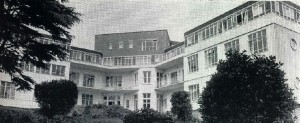History of St Teresa’s
The past thirty five years of St. Teresa’s Home, is only the latest chapter in its history. It has been a prominent landmark in South London life for a long time.
St Teresa’s Home opened in 1938 as a home providing pre- and post-operative care for women suffering from cancer or from advanced heart disease. The Home had been founded by the Mother Superior of the Convent of St Anne, who funded the Convent and the Home, whilst also acted as Matron of the Home. The Home’s Patron was the Archbishop of Southwark.
Patients were referred from the London teaching hospitals – St Bartholomew’s, St Mary’s, St Thomas’, Westminster, St George’s, the Middlesex, the Royal Free and the London.
During WW2 a Children’s Ward was opened in July 1942 at the request of Dr Charles Pinckney, the Honorary Physician to the Victoria Hospital. In 1943 the Home suffered bomb damage.
The Home was disclaimed from the NHS in 1948 and remained independent. It had 28 beds for cancer patients and 10 beds for children with acute disease.
St Teresa’s Maternity Hospital was officially opened by Sir William Gilliatt, gynaecologist to the Queen, in January 1951. It had been extended to have 40 beds.
The new 2-storey building was officially opened on 5th December 1956 by Sir Horace Evans, physician to the Queen. By this time the Hospital was working almost entirely for the Regional Hospital Board. All the maternity nursing homes in the Wimbledon area had closed as the patients were unable to pay the high charges.
In April 1959 a new wing was officially opened by Lady Dorothy Macmillan, wife of the Prime Minister. It was the third major extension of the Hospital to be completed during the decade.
In 1967 the South West Metropolitan Regional Hospital Board decided to withdraw its grant on the grounds that a new maternity unit of 35 beds was being made available at Queen Mary’s Hospital, Roehampton.
Despite a petition of 35,000 signatures and a ‘march of prams’ to the House of Commons in protest of the withdrawal of the subsidy, the Board carried out its plan and, from January 1968, NHS patients were referred to Queen Mary’s Hospital. The Hospital, now deeply in debt due to its latest extension, refused the offer of an alternative contract from the Board to provide care for geriatric and chronically sick patients on the basis that converting the buildings for such a purpose would be prohibitively expensive.
By 1971 the Hospital was able to offer a limited maternity service following a fund-raising campaign by the 300-strong League of Friends of St Teresa’s Hospital. The League consisted of local people who gave up their time to do clerical work, help in the linen store, man the switchboard, help in the hospital shop, etc.
In May 1986 the Sisters of St Anne announced their intention to sell the Hospital because of changing needs in the community. St Teresa’s Home for the Elderly opened on 15th August 1988 with 28 beds and continues to be run by the Sisters of St Anne. On 1st December 2021 the Home became St Teresa’s Home CIO and currently has 24 beds.


